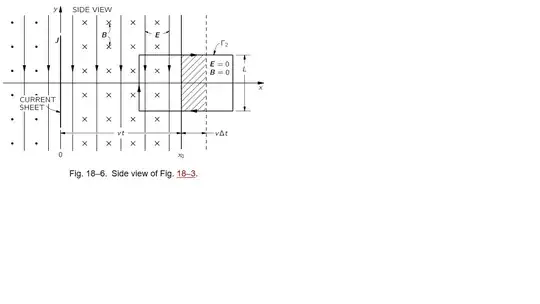In The Feynman Lectures on Physics Vol II 18-4, A travelling field we are provided the thought experiment of two uniformly and oppositely electrically charged planar sheets of infinite extent lying in close proximity. The charge densities are equal in magnitude so that their net charge is zero. Let one lie in the $Y\times{Z}$ plane and the other lie indistinguishably near the first. The positively charged sheet is instantaneously set in motion parallel to itself at a constant speed in the positive $Y$ direction.
The assertion made by Feynman is that this sets up a surface current density which induces a magnetic field which propagates away from the charged planes and in so doing induces an electric field pointing in the negative $Y$ direction.
I understand why this might seem like a useful model. I was at first confused about the persistence of the electric field behind the wave-front. I posted about that Feynman Lectures Vol II-18 A travelling field: I'm not getting Feynman's result a while back.
But now I have another objection. According to Vol II 13-6 The relativity of magnetic and electric fields the magnetic field induced by an electric current is actually a result of relativistic length contraction. The conducting wire considered in 13-6 is supposed to be neutrally charged in its rest frame. When a test charge moves along the direction of the wire, the apparent charge densities of the wire's stationary positive charges and moving negative charges become different due to differences in their motions relative to the test charge.
For example, if the test charge moves with the average velocity of the conducting electrons, the conduction electron density is decreased from that of the wire's rest frame by a factor of $1/\gamma$, since relative to the wire's rest frame the conducting swarm appears length contracted. The positive charge density of the wire minus the conducting electrons appears to the test charge to be increased by a factor of $\gamma$ because it appears length contracted.
In the case of the charged sheets, before set in motion, the "conduction" charges have the same rest density as the "neutralizing" charges of the sheet that remains at rest. Once set in motion, the moving sheet become length contracted relative to the initial rest frame. Since the magnetic effect of current has already been shown to be a purely relativistic result, it seems impossible to neglect it by arguing that we are dealing with "non-relativistic velocities".
By the above reasoning, I conclude that once the "conducting" sheet is in motion, in the initial rest frame there will be a non-zero $X$ component of the electric field. I have yet to figure out how the $-Y$ component of the electric field can be accounted for using the relativistic approach of 13-6.
Is my understanding of this correct in so much as there should be a $X$ component of the electric field produced by the pair of sheets once the "conducting" sheet is set in motion? How might the $-Y$ component of the electric field advertised by Feynman be accounted for using the approach of 13-6?
